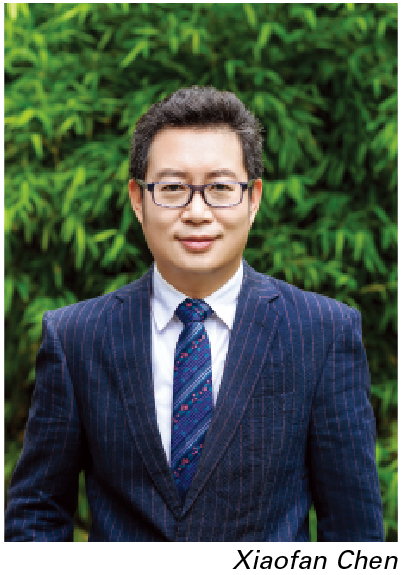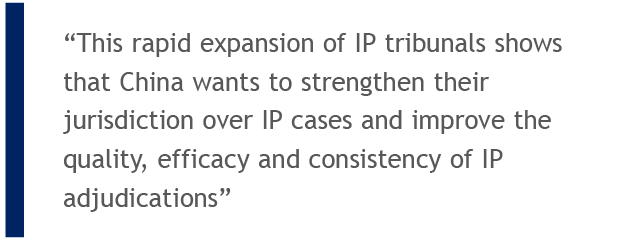 By Ai-Leen Lim and Xiaofan Chen of AWA Asia
By Ai-Leen Lim and Xiaofan Chen of AWA Asia
E: ai-leen.lim@awa.com
E: xiaofan.chen@awa.com
A clear signal has been sent over the past year that IP rights are to be respected in accordance with the law.
The intellectual property environment in China has seen significant developments over the past 12 months. IP reform has been at the front of the Chinese government’s economic agenda, with several developments enacted and other impending changes coming up.
The announcement from the Chinese government on the merger of the patent and trademark offices into a single combined IP office has been applauded by the IP community. This will likely result in stronger protection and accordingly enforcement opportunities for rights holders. In another move, stripping many general courts of their IP jurisdiction and placing the same with specialised IP tribunals could prove beneficial to IP owners who have legitimate rights they wish to enforce.
In two landmark trademark cases, Under Armour won a major victory for trademark infringement, as did New Balance over its N letter design in one of the largest trademark damage awards awarded to a foreign company, echoing President Xi Jinping’s words: “Wrongdoing should be punished more severely so that IP infringers will pay a heavy price.”
President Xi made these remarks during the National Financial Work Conference in July last year and they are thought to be the most extensive remarks he has made in public on the subject of intellectual property enforcement.
The international business community has been watching these and many other developments unfold closely because the IP regime in China as we know it is changing. A clear signal has been sent over the past year that IP rights are to be respected in accordance with the law — not only to please or appease foreign investors, but also for the benefit of domestic companies as they grow in stature and relevance on the world stage.
The growth in IP filings in China has been exponential — last year alone more than 5.7 million trademark applications were filed with the China Trademark Office (CTMO), an increase of more than 55 percent from the previous year. The number of patent applications for inventions reached 1.3 million, an increase of 14.2 percent compared to 2016. Most of the filers are Chinese nationals or entities.
IP litigation numbers have risen drastically as well. The courts accepted a total number of 237,242 new IP cases of first instance, second instance and retrial (up 33.5 percent) last year and concluded 225,678 cases (up 31.43 percent) compared with 2016.
Surging past the 200,000 mark for the first time, Chinese IP cases have more than doubled in four years. That is about 18 times greater than the total figure for new patent, trademark and copyright cases in US federal courts during 2017, which was 11,602.
The authorities investigated 17,000 cases related to IPR violations or making and selling counterfeit products last year, involving a combined sum of Rmb6.46 billion (US$1.02 billion). Shen Changyu, head of the State Intellectual Property Office (SIPO), has stated that China’s strengthening of IP protection is not only due to international obligation, but also because the country’s own development demands it.
The government’s 13th Five Year Plan had foreshadowed this chain of legislative and administrative pronouncements. Its focus on economic growth through innovation and boosting of local consumption have no doubt brought about this flurry of legislative and administrative rulings. China is no longer satisfied with being the factory of the world, it seeks to be a place that supports innovation with strengthened IP enforcement and protection as the backbone to realising the goals of “Made in China 2025”, adding innovation to its total industrial output. Foreign IP owners should ride this wave and benefit from it.
SIPO Restructuring
During the first session of the National People’s Congress on March 13, 2018, China’s government approved a large-scale restructuring of SIPO, which is responsible for all patent-related matters and coordinating foreign-related affairs in the field of intellectual property rights.
The restructuring incorporates the Trademark Office of the State Administration for Industry and Commerce (SAIC) and the Administration for Quality Supervision, Inspection and Quarantine as regards geographical indications.
 The restructured SIPO will be responsible for accelerating the establishment of a protection system for IP rights, the granting and adjudication of trademarks, patents and geographical indicators, and the supervision of related law enforcement.
The restructured SIPO will be responsible for accelerating the establishment of a protection system for IP rights, the granting and adjudication of trademarks, patents and geographical indicators, and the supervision of related law enforcement.
Consolidating trademarks, geographical indications and patents shows the government’s determination to further strengthen IP protection in China. The move is also encouraging for rights holders as their intellectual property can be protected and enforced under a single office in the future.
The reshuffle could also signal stronger enforcement opportunities for patent holders by utilising the power and experience of local Administrations of Industry and Commerce. Historically, these local authorities, under the supervision of the SAIC, have been very strong and effective in tackling trademark infringement through administrative procedures.
SIPO will administratively come under the newly created State Administration of Market Supervision and Management (SAMSM)1. In addition to SIPO, the SAMSM will oversee the National Development and Reform Commission’s price supervision and antitrust enforcement functions, the Ministry of Commerce’s antitrust enforcement functions and the State Council’s Antitrust Committee.
This consolidation creates a powerful overarching oversight over the intellectual property protection regime in China and the opportunity to improve the efficiency of law enforcement and ensure consistency when interpreting and practising legal matters under different regimes.
Expanding IP tribunals
China has continued to develop its adjudicatory framework for intellectual property disputes as the total number of IP tribunals reached 15 in March of this year. The tribunals are part of the IP courts system, stemming from the three specialised IP courts created in Beijing, Shanghai and Guangzhou in late 2014.
The IP courts were created to try cases involving patents, trade secrets, computer software and cases regarding recognition of well-known trademarks and antitrust issues. The IP tribunals have a similar function to IP courts, but operate within the local-intermediate court system and are comprised of 12 to 15 judges, all with extensive IP litigation experience.
The IP tribunals have cross-regional and exclusive jurisdiction over IP matters in first-instance cases and their jurisdiction extends beyond the city’s Intermediate Court where they are located. This power has stripped many Chinese courts of their jurisdiction over IP disputes, leading to a fundamental change in the forum selection strategies of both multinational and Chinese companies.
IP tribunals may also help to alleviate concerns about regional protectionism, because many defendants will not be sued in their own cities. For example, Xi’an is the capital city of Shaanxi Province, and one of 11 cities in the province, and although the Xi’an IP Tribunal is a part of the Xi’an Intermediate People’s Court, its jurisdiction over significant IP matters covers all of Shaanxi Province.
For companies facing an IP dispute in China, understanding the IP tribunal framework and jurisdiction is paramount in order to select the appropriate jurisdiction for a case as location can have a significant impact on the time to resolution, as well as the ultimate merits of the case.
 This rapid expansion of IP tribunals shows that China wants to strengthen their jurisdiction over IP cases and improve the quality, efficacy and consistency of IP adjudications. It also shows a determination to establish an IP judiciary system separate from the administrative divisions (provinces, province-level municipalities and cities within a province).
This rapid expansion of IP tribunals shows that China wants to strengthen their jurisdiction over IP cases and improve the quality, efficacy and consistency of IP adjudications. It also shows a determination to establish an IP judiciary system separate from the administrative divisions (provinces, province-level municipalities and cities within a province).
It has been widely speculated that China will eventually set up a unified IP appellate court, similar to the US Court of Appeals for the Federal Circuit. On a number of occasions, officials and judges of the Supreme People’s Court have expressed support for the establishment of such a court. This would further enhance adjudicative consistency between IP administrative proceedings and infringement actions, and among different trial court decisions. It may also help to eliminate local protectionism.
Patent Law amendments
The State Council Legislation Plan for 2018 was released in April 2018, specifying that the draft of the amended Patent Law would be submitted to the Standing Committee of the National People’s Congress for deliberation. This suggests that the text of the latest draft version Patent Law will likely be adopted as is. It is expected that the amendment will be issued later this year.
Highlights from the amendment include a partial design becoming an eligible subject matter for design patents, extending the term for design patents to 15 years, increasing statutory compensation (from Rmb1 million to Rmb5 million) and punitive damages for wilful infringements (up to three times the damages assessed), imposing fines, clarifying indirect infringement liability and mediating the amount of compensation.
Notably, the amendments also introduce new provisions regarding the good faith principle when applying for patents and exercising patent rights, and a credit record on the protection of patent rights to be established and incorporated into the national credit database.
The amendment also requires internet service providers (ISPs) to delete, block, disconnect or take other preventive measures to prevent patent infringement if they know or should have known the existence of patent infringement. The draft further allows patent right holders and SIPO to notify the ISP (which in China includes e-commerce platforms) to adopt preventive measures after being notified of patent infringement, otherwise the ISP shall be jointly liable with network users for the preventable losses.
Patentable business methods?
On February 28, 2017, SIPO announced its decision to Revise the Guidelines for Patent Examination (Revised Guidelines), which became effective on April 1, 2017. The Revised Guidelines provide significant changes to business methods.
Previously in China, patent applications involving business innovations in e-commerce faced patent eligibility challenges. Examiners used to reject these applications forthwith as not constituting a technical solution when they were considered to fall within the category of business methods.
The following has been added to Section 4.2, Chapter 1, Part II in the Revised Guidelines for Patent Examination: “For claims involving business models, if they contain both the content of business rules and methods and technical characteristics, the possibility of obtaining patent rights shall not be excluded under Article 25 of the Patent Law.”
This suggests a sort of lowering of the allowance bar as it opens new doors for business methods with technical features to be allowed patent protection. While this does not guarantee patentability as the technical elements test still remains, many have interpreted the above Guidelines to assist patentees who have business method-type claims. Applicants must still prove or argue technical contribution for a business method-related application in order to be eventually patented.

For e-commerce, banking, securities and insurance-related businesses the relaxation is encouraging news. In the past, companies in these fields have discounted using patents to protect their innovations due to the rarity of applications being granted. The Revised Guidelines have prompted more companies to actively file patent applications to keep their competitive edge, especially in the booming industries of fintech and insurtech.
Other companies that may benefit from the relaxation are tech companies engaged in the development of social media as their core products and services, previously considered as relating to ways of doing business in operating organisations and institutions, thus being an unpatentable subject matter are now are eligible for patent protection.
Landmark trademark cases and CTMO reforms to shorten processing time
In August 2017, the Suzhou International People’s Court ruled that three domestic shoemakers must pay New Balance US$1.5 million in damages and legal costs for infringing the American sportswear company’s signature slanting N logo.
This is definitely one of the largest trademark infringement awards ever granted to a foreign business in China and is not only a victory for New Balance, but also for many other foreign companies that have long complained that China has not done enough to protect their brands.
Also in August, Under Armour won a major victory against the Chinese sportswear company Fujian Ting Fei Long Sports Products, which had used a similar logo to one used by Under Armour for its Uncle Martian athletic footwear.
The Higher People’s Court of Fujian Province ruled in favour of Under Armour, finding that Fujian Ting Fei Long Sports Products’ use of the logo constituted trademark infringement and awarded the plaintiff approximately Rmb2 million.
This case was important because the preliminary injunction was awarded before the matter was tried in full, which was relatively rare in the past. The Court approved Under Armour’s application for a preliminary injunction and ordered the defendant to immediately stop the manufacturing, selling or advertising of shoes and clothing using the contested logo.
CTMO is making way to facilitate the registration, recordals, renewal and assignments of trademarks. By the end of the 2018, CTMO will shorten the window for trademark search (time lag between the trademark details available on the CTMO website and the filing of the trademark application) from three months to two months.
The office will also shorten the examination period for national trademark registrations from nine months to six months; for issuing filing receipts from two months to one month; for trademark assignments from six months to four months; and for recordals of changes and trademark renewals from three months to two months.
Moving forward
This is the “new China” that many have been looking forward to and have not expected to see so quickly, and so readily progressed by the central government. It is only in China that changes can take place as such breakneck speed, and from the perspective of IP practitioners on the ground here, we believe that the best is yet to come.
1. SAMSM : The official English name is not available at this time — this name is based on a translation of the Chinese
國家市場監督管理總局管理
W: www.awa.com
E: ai-leen.lim@awa.com
E: xiaofan.chen@awa.com














 AWA Asia
AWA Asia Ai-Leen Lim
Ai-Leen Lim







